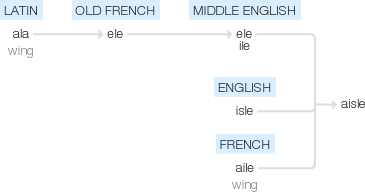Aisle
late Middle English ele, ile, from Old French ele, from Latin ala ‘wing’. The spelling change in the 17th century was due to confusion with isle and influenced by French aile ‘wing’.
wiktionary
From Middle English[Term?], from Middle French aisle(“ wing”) (Modern French aile), from Latin āla.
etymonline
aisle (n.)
late 14c., ele, "lateral division of a church" (usually separated from the nave or transept by a row of pillars), from Old French ele "wing (of a bird or an army), side of a ship" (12c., Modern French aile), from Latin ala, related to or contracted from axilla "wing, upper arm, armpit; wing of an army," from PIE *aks-la-, suffixed form of root *aks- "axis" (see axis). The notion is of "turning," which also connects it with axle.
Confused from 15c. with unrelated Middle English ile "island" (perhaps from notion of a "detached" part of a church), and so it took an unetymological -s- c. 1700 when isle did; by 1750 it had acquired an a-, on the model of French cognate aile. English aisle perhaps also was confused with alley, which helped give it the sense of "passage between rows of pews or seats" (1731), which subsequently was extended to railway cars, theaters, Congress, etc.
